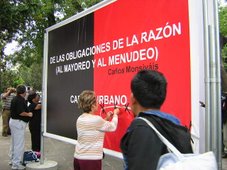Racists, anti-racists clash in Calgary
Calgary Herald; March 22, 2009
A neo-Nazi march through downtown Calgary deteriorated into violence as counter-protesters lobbed rocks and tin cans at the group.
Onlookers gaped as Saturday's confrontation between between white supremacists and anti-racist activists brought downtown traffic to a standstill.
Several fist fights broke out and at least two people were treated for head injuries after being hit by projectiles, although the injuries weren't serious.
The Aryan Guard march drew heated emotion from activists troubled by the signs of intolerance.
"I think it's extremely important, any organization that tries to promote hatred, tries to promote a violent ideology . . . they must be opposed," said Jason Devine of Anti-Racist Action Calgary, a group that spearheaded the counter-protest against the marchers.
More than 400 anti-racist protesters confronted about 60 Aryan Guard.
At first, 56 downtown police officers tried to control the rowdy throng; an additional 30 officers were called in for reinforcement. Authorities broke up several fights between the two sides along the way and often formed a human barricade to keep the groups apart.
**********
Foreign workers deserve protection
Source: The Edmonton Journal / March 9, 2009
There are an estimated 57,000 temporary foreign workers in Alberta. Unfortunately, these workers face many challenges and injustices.
The government claims temporary foreign workers have the same rights as other workers, but they do not. In Alberta, temporary foreign workers are prohibited from attending any educational institution or taking any academic, professional, or vocational training; from working in any occupation other than that stated on their visa; from working for an employer other than the one listed on their visa, and from working in any location other than stated on their visa.
These restrictions make it impossible for temporary foreign workers to find better employment if they find themselves in a bad situation -- and that happens more often than Albertans realize.
The wages of temporary foreign workers are often lower than promised. Sometimes, the jobs are different than advertised. Sometimes, the jobs promised are not available when the workers arrive. Perhaps most troubling, some temporary foreign workers are being charged illegal broker fees between $3,000 and $10,000.
Language barriers and a lack of understanding about Alberta's labour laws make it difficult for temporary foreign workers who are being mistreated to get help. If the temporary foreign worker program really worked, it wouldn't be necessary for the province to spend millions of dollars trying to fix the problems.
The government needs to end the program, while allowing those temporary foreign workers currently here to finish the time left on their visas. Many temporary workers are now unemployed, with few job prospects. The government should shift its focus to recruiting workers through the Alberta Immigrant Nominee Program, where those nominated have the same rights as all other workers and can become permanent citizens.
Last year, the provincial government fell short of its target of 2,500 provincial nominees. This program, operated in conjunction with Citizenship, Immigration and Multiculturalism Canada (CIMC), allows workers nominated by the province, together with their spouses and dependent children, to apply for a permanent resident visa through CIMC.
************
Canada's unemployment rate rises to 7.7 per cent
Source: Agencies
Fri. Mar. 13 2009
Canadian employers slashed 82,600 jobs in February, pushing the unemployment rate up to 7.7 per cent, Statistics Canada reported Friday.
According to the report, all of the employment losses in February were full-time positions (110,900), while part-time employment edged up slightly (28,300).
The largest job losses were in Ontario, where employers cut 35,000 positions.
"Since last October, just over half of the country's total employment losses have occurred in Ontario, well beyond the province's 39 per cent share of the total working-age population," Statistics Canada noted.
Alberta was second with 24,000 job cuts in February while Quebec lost 18,000.
Employment decreased the sharpest in the construction industry with more than 43,000 jobs lost in February.
Meanwhile, the hardest hit segment of the labour force was young male workers. In the past four months, employment among men aged 15 to 24 decreased by 104,000.
Economists had been expecting the report to show an overall loss of about 50,000 jobs in February.
"Between all the job losses concentrated on full-time positions and the unemployment rate bouncing up more than expected it was clearly a very weak report from head to toe," Douglas Porter, deputy chief economist at BMO Capital Markets, said in a note.
The losses build on the 129,000 jobs slashed in January. Since last October, Canadian employers have axed 295,000 jobs.
"A U.S. style pace of labour market deterioration has landed on Canada's doorstep," Derek Holt, an economist at Scotia Capital, said in a note.
Ken Georgetti, president of the Canadian Labour Congress, said the government needs to move quicker to help unemployed workers.
"These people had no part in the economic crisis, they're victims," Georgetti told CTV's Canada AM on Friday. "When they need the support from their employment insurance program and they need their government to back them up they ignore them."
The only provinces that did not record job losses were Prince Edward Island, Nova Scotia, Manitoba and Saskatchewan.
Last week, the U.S. Labour Department reported 651,000 jobs were lost south of the border in February.
The cuts pushed the U.S. unemployment rate to 8.1 per cent, which is at its highest level since 1983.
In total, roughly 12.5 million Americans are now unemployed.
Monday, March 23, 2009
Subscribe to:
Post Comments (Atom)



No comments:
Post a Comment